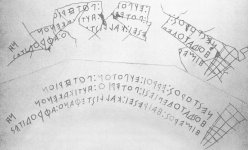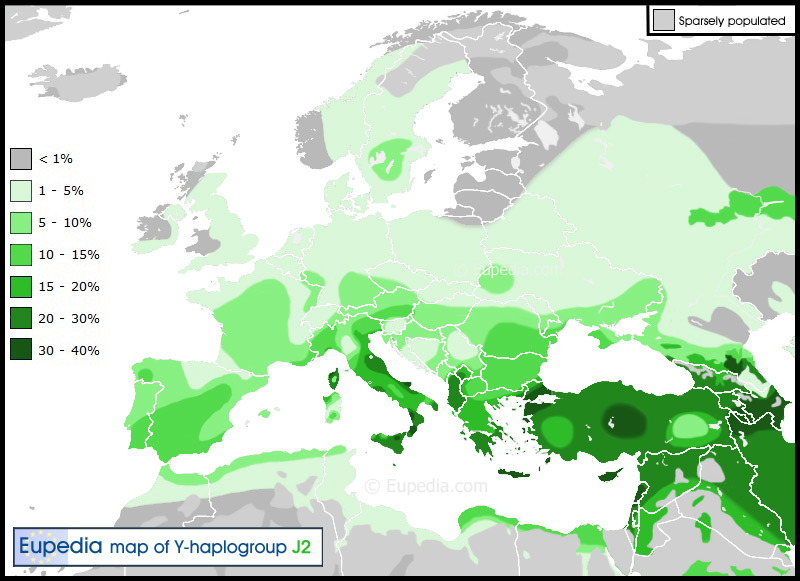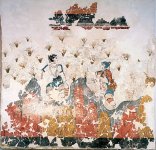iapetoc
Junior Member
zanipolo, there are topics of Veneti...and you can also open new ones...let's not spam here....
btw. I expect reference for what you claim above...because according to story written down by Strabo Veneti were most notable of all Paphlagonians, now you claim they were not Paphlagonians...and you also insert Illyria whereas in Strabo's story Illyria is not mentioned and Veneti moved to Thrace and than to Adriatic... regarding you thinking that Venethi and Veneti are different tribal names, I am pretty convinced that it is same tribal name...it is another question what were the circumstances that led to those people having same tribal name... was it same genetic origin or not... I think it was.. R1a + I2a2...
now, back to Etruscans
father= apa
mother =ati
wife = puia
brother
http://books.google.nl/books?id=VWGN6e5Rzf8C&lpg=PA57&dq=venetic%20vocabulary&pg=PA58#v=onepage&q=venetic%20vocabulary&f=false
fire = uerse
god(s) = aisar
monkey = arimos
king = lucumo
freedman = lautni
son = clan
daughter = sech
grandson = nefts, papals
grandfather = papa
grandmother = teta
children = husiur
parents/ancestors = ateri
dictator = purth
mirror = malena
June = aclus
I = mi
me = mini
you = un
for you = une
who/which = ipa
whoever = ipe ipa
stranger,client, slave = etera
bellow = hinth
gold = zamathi
city = spura
image = sren
year = avil
month = tiur
at first = thuni
again = etnam
now = thui
here = thui
until = epl, pul
also = etnam
writing/book = zich
Aristotle claims that Etruscans and Carthaginians are so close that they almost make one people....
http://books.google.nl/books?id=VWG...g=PA68#v=onepage&q=venetic vocabulary&f=false
On Greek island of Lemnos there are inscriptions from 6th century similar to Etruscan ones both in alphabet and vocabulary...
http://books.google.nl/books?id=VWG...g=PA61#v=onepage&q=venetic vocabulary&f=false
Lemnos is close to Lydia, Carthaginians or Phoenicans origin from southeast of Asia minor... thus languages/culture similar to Etruscan also origin from south of Asia minor...
Let'see who lived on Lemnos
http://en.wikipedia.org/wiki/Lemnos
now, if the Albanian interpretation of inscriptionfro the start of the thread is correct, that would mean that the languages are practically the same... thus, most of the words bellow should exist in albanian as well.. I will add next to it serbo-croat and greek words...words are taken from google translate... so native Albanian and Greek speakers should react if they see etruscan word that has cognjate in their languages...
english - etruscan - albanian - greek - serbo-croat
father= apa = baba, ate = patéras = otac, tata
mother =ati = nënë, mëmë, burim = mi̱téra = majka, mama, mater, mati
wife = puia = grua,bashkëshorte, shoqe = gynaíka = zena, supruga
brother = ruva = vëlla, shok = adelfós = brat
fire = uerse = zjarr, pasion, fugë, ethe =pyrkagiás = vatra
god(s) = aisar = perëndi= theoí = bog/bogovi
monkey = arimos = majmun, çamarrok = maïmoú = majmun
king = lucumo = mbret, car = vasiliás = kralj, car
freeman = lautni = njeri i lirë, qytetar = eléf̱theros = slobodan
son = clan = e saj = tou = sin
daughter = sech = bijë, vajzë = kóri̱= (k)cerka, kci
grandson = nefts, papals = nip = engonós = unuk
grandfather = papa = gjysh, stërgjysh, babagjysh = pappoús = deda
grandmother = teta = gjyshe = giagiá = baba, baka (teta = older woman, aunt)
children = husiur = fëmijëve = paidiá = deca
parents/ancestors = ateri = prindërit/paraardhësit = goneís/Oi prógonoí = roditelji/ preci, oci
dictator = purth = diktator = diktátoras = diktator
mirror = malena = pasqyrë, shembull = kathrépti̱s = ogledalo
who/which = ipa = ke, cili, kush = o opoíos, i̱ opoía = ko, koga
whoever = ipe ipa = kush = opoiosdí̱pote = kogod (however = ipak)
stranger/client/slave = etera = i huaj, i panjohuri/klient, blerës, myshteri/rob, skllav = xénos / peláti̱s /doúlos = stranac / klijent, musterija / rob
bellow = hinth = më poshtë, pallje = parakáto̱ = ispod
gold = zamathi = ar, flori = chrysós = zlato
city = spura = qytet = póli̱ =grad
image = sren = imazh, figurë, shëmbëlltyrë = Eikóna = slika
year = avil = vit, vjet = étos = godina
month = tiur = muaj = mí̱na = mesec
again = etnam =përsëri, sërish, prapë= kai páli = opet
now = thui = tani, tash = tó̱ra = sad
here = thui = këtu = edó̱ = ovde, tu, tuj
until = epl, pul = deri, gjer = méchri = do
also = etnam = gjithashtu, edhe = Epísi̱s = takodje, isto
writing/book = zich = shkrim, shënim, gramë/ libër, blok = graptó̱s/vivlío = pisanje/knjiga
to conclude, it is obvious that neither of the languages above has much to do with Etruscan... considering this, the idea that the etruscan text above has direct meaning in Albanian as proposed by some albanian scientist is not likely at all.. same text is by people studying Etruscan considered to have completely different meaning (legal contract and not story about ghost in a cave)...
lets see 1 by 1
i don't know it is pronounced but i ll try
uerse fire + p = puerse ??? pur Πυρ ΙΕ or not hmmm could be IE
But Θυω thuerse? sacrifice, burn in fire Θυω Noun Θυσια BINGO
aisar gods aei? for ever, eternals νυν και αει? hmmmm could be IE
Lucumo Λυκιας no don't believe so
Lautni ελευθερος εν λεφ in free noτ εις κλωβο Bingo en + leut +end
son clan τεκνον naaa
daughter sech naaaa
grandson = nefts, papals how about nephew ανιψιος aniphs-ios Bingo grandson = nefts, papals could be IE
grandfather = papa papoys Bingo could be IE
grandmother = teta γιαγια βαβω naaaaa
children = husiur hus υιος uios Bingo
parents/ancestors = ateri pateri BINGO could be IE
dictator = purth τυρρανος p->t hmmm or naaa
mirror = malena naaaaa
June = aclus naaaaa
I = mi not to compare
me = mini not to compare
you = un not to compare
for you = une
who/which = ipa ποιος poios Bingo
whoever = ipe ipa 'οποιος opoios BINGO
stranger,client, slave = etera εταιρος ΒINGO
bellow = hinth h->ch->k κατω kato BINGO ???? hmmmm
gold = zamathi naaaa
city = spura r->l spula Πολις Polis Hmmmmm
grandfather = papa papoys Bingo
grandmother = teta γιαγια βαβω naaaaa
children = husiur hus υιος uios Bingo
parents/ancestors = ateri pateri could be IE
dictator = purth τυρρανος p->t BINGO????
mirror = malena naaaa
June = aclus naaaa
I = mi not to compare
me = mini not to compare
you = un not to compare
for you = une not to compare
who/which = ipa ποιος Poios BINGO
whoever = ipe ipa opoios BINGO
stranger,client, slave = etera etairos εταιρος BINGO
bellow = hinth h->ch -> κατω -> κατο BINGO ???
gold = zamathi naaaa
city = spura r->l Πολις polis Bingo ??????
image = sren naaaa
year = avil waht about sivai vi = live εβιωσε eviose BINGO
month = tiur naaaa
at first = thuni naaaa
again = etnam et+nam GR εξ +ανα -> Ξανα root is ανα ana nem BINGO
now = thui naaaaa
here = thui thui th as in they? or as in thalassa Greek εδω edo could be IE like ovde ?????
until = epl, pul I think there is a Homeric word near aprion But not sure ?????
also = etnam naaaaa
writing/book = zich well ancient pelasgian virb λαξευω la+xeph Z phoenician is Ξ in Greek so Zinch -> Xeph in Pelasgic
λαξευω means i write in stone lazich BINGO
as you see there are many bingo
enough to prove if you add the rest in my previous posts,
Carthageneians or Carcheidonians (shark people, or First people) were Phoenicians or simmilar,
Etruscans are also considered more Phoenicians than IE
Pelasgians are considered the non IE Greeks that create civilization next to Thracians and among the Thracians
Pelasgians are connected with Phillistines and Phoenicians,
I am not talking about modern Albanian language, but for ancient Illyrian,
modern Albanian is Satem, and very mixed,
but ancient Illyrian was centum, and many works connect ancient Illyrian with Pelasgic,
If a good literature man could connect remnants of ancient Illyrian with etruscan in some phrases is not a prove,
the way that Julia put it truscans = Albanians is wrong
same way Ligurians = Armani and Lombardians = Romanians
Pelasgians should Be J2 people, J2 can be found everywhere where Greeks make colonies, also where phoenicians made colonies also in Central Italy,
In Homer we read that Greeks and Troyans could communicate with out translators,
also Achilleas speak to king Priamos with out translator
also Odysseas in a question he mention that Ithaka has need of Mycenae, that is why he ally with them,
both above prove that Pelasgians at Mycenae times spoke 2 languages IE and Pelasgian
That Myrmidons and Troyans spoke same language,
I don't know who was IE or who was pelasgian
but the maps of J2 suits exactly,
Remember that Nestor's cup is written in Pelasgian letters
from right to left

I know that modern Albanians are not Etruscans,
and I know that many Albanians work hard to make Propaganda,
but the case of Pelasgians as ancestor nation culture and language of many is true,
even bible says so,
and is not only eteocretans, but eteocretans kept pure and less IE or Arabian than all others
my 2 problems is the Iapodes and The Thracians,
If Iapodes were E-V13 or J2
or Thracians were I2a2 the whole Puzzle will be solved










